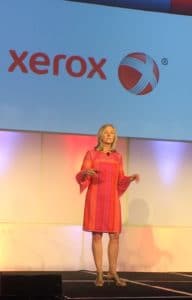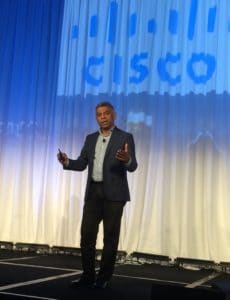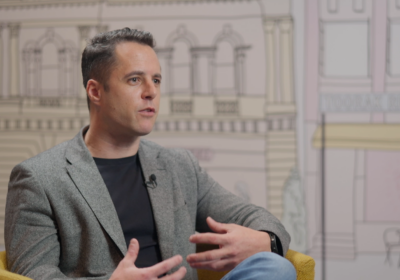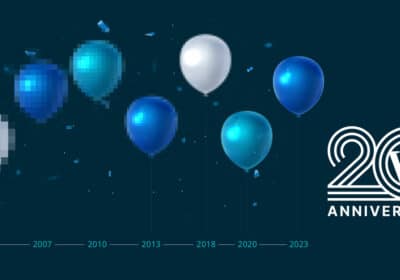Courage to try new things, decisiveness to execute and a strong focus on brands will help enterprise marketers navigate a tough business environment, according to a meeting of business leaders.
The ability to parse data both before drawing up a marketing plan and to measure its results after executing can help marketers face business to business branding needs that are strongly influenced by expectations built on the consumer area, said speakers at the annual B2B conference of the Association of National Advertisers.
Expectations for enterprise marketers are being set by consumer expectations “therefore everything about our environment has to change,” said Joseph Puthussery, VP of digital marketing at Cisco. Customer experience is becoming a differentiator in B2B ecommerce, which Forrester projects will become a $1.2 trillion industry by 2021, he said.
“What we’re seeing in the B to B marketplace is consumer tendencies coming into the B to B world,” said Mike Simpson, CMO of Stanley Black & Decker.
Enterprise marketers are learning to deploy consumer tactics in the B to B world because clients’ expectations are now driven by consumer experiences like shopping on Amazon. Simpson noted one B2B customer asked why he could get all the specs on a $5 item on Amazon or go to BMW’s site and built a car to their taste, but couldn’t do that with his company.

“I’m of the mindset that we’re B to P,” said Barbara Basney, CMO of Xerox. “Businesspeople are people too, or people first.”
Puthussery noted that Cisco had to transform from a product-centered company with “a culture that was all about product launches and events” to a customer-centered company. That required a shift to focus on customer experience, analytics, compelling content, performance marketing and automation.
It will be a tall ask, said most speakers, but it is necessary. “The future is inevitable,” said Puthussery. “Our job is to deal with it.”

The use of marketing analytics has grown, yet marketers are still skeptical about the effectiveness of their efforts, said Tom Armentrout, EVP and managing director of B-to-B agency Mower. According to recent surveys, their feeling about the effectiveness of initiatives “really just bumped around the middle,” he said. Meanwhile, marketing budgets are declining according to the most recent Gartner surveys, because companies are demanding more accountability for spend, he added.
“It’s critical that you connect it to the bottom line, because as you all know, marketing is the first place that they will cut, but if you can demonstrate how valuable you are to the company,” said Hue Du, VP marketing and communications at Equipment Depot, another company that also had to undergo a transformation. “You have to demonstrate the value of marketing to the organization.”
Employee engagement is also key, especially in sales and customer service, said speakers. Stephanie Smith, chief marketing and brand officer at Sentry Insurance faced that when some executives fought a rebranding of the 114-year-old mutual insurer. They had a long relationship with the old branding, she explained, but research showed there was a business case to take the leap. Still, she admits current and retired employees had to be sold on the idea.
“I did not want to go down in history as the woman who screwed up the brand,” she said. “I took an earful at the company picnic.”
“We market together”
Building relationships with other departments is key, especially the alignment of marketing and sales, according to several marketers. Marketers need to form need interdisciplinary teams, said Armentrout: “We don’t market alone anymore, we market together.”
Many speakers said they began their transformation efforts by improving communication with employees. Simpson said Stanley’s marketers went to the entire workforce to “excavate our purpose” when launching a transformation campaign. “It wasn’t a bunch of stuffy executives from the top coming up with an idea,” he said.

The bank needed to enable its people to go into social media, so it replaced a “really punitive” social media policy with one more open to encourage sharing, but established some best practices . Marketing also helped some executives update and improve their LinkedIn profiles and manage them, acknowledging the platform is a key channel for business contacts.
“It’s really like building a new muscle,” said DeLaney.
If budgets are tough, the squeeze on talent is even more marked among the B to B marketers, many speakers agreed. Many enterprise marketers said the need to show purpose and energize the brand in order to attract talent was a factor in their transformation calculations. DeLaney said the Hamilton campaign has energized the bank’s sales staff and “from the recruiting side, they’re delighted.”
Millennials are not the only employees who need to feel their employers sense of purpose, said Simpson. “Performance and profit are not enough. Today the new commodity is purpose,” he said.

Enterprise marketers will have to wrestle with the choices of technology for a marketing stack, to track ROI, sort sales leads and also to personalize and target much like consumer-facing marketers. B to B marketers won’t get a pass from those duties, said speakers.
Technology is still a difficult area for most enterprise marketers. CA’s Preschern asked the audience for a show of hands: How many felt comfortable with their marketing stack? A few hands went up, but when he asked how many were uncomfortable with it, nearly twice as many hands went up.
Drawing an analogy to the current French Open tennis tournament, Preschern noted some players are obsessed with rackets, but neglect their game. “You cannot be a successful marketer if you don’t take advantage of marketing technology,” he said, “but you also won’t win a match if you think you can play tennis with a wooden racket.”
Marketers don’t need to be investing constantly in new technology, but they need to make sure what they have is understood by the employees and it’s connected to the CRM systems.
“Technology is our friend, but that alone won’t deliver us… from the sea of sameness,” said Preschern. “Technology is the enabler, but the marketeers are still responsible for human connection”





Join the conversation